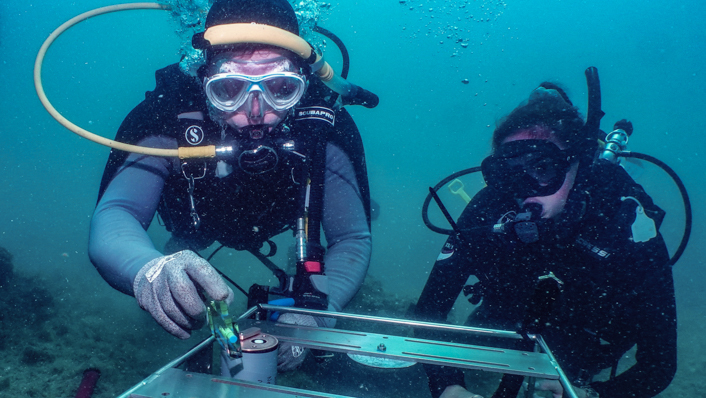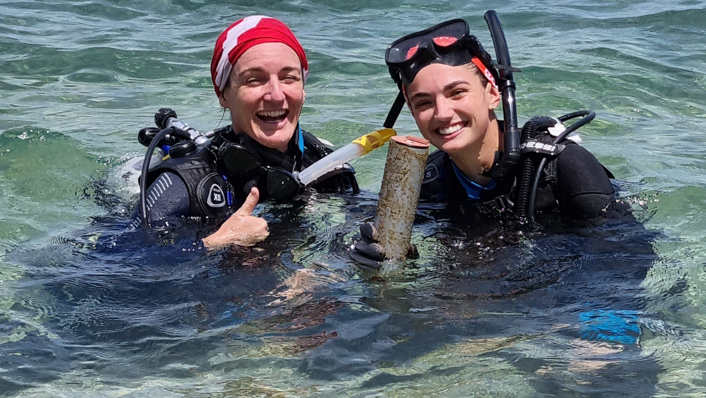Summer is a challenging time for coral reefs.
Two cyclones and flood plumes have already affected the Great Barrier Reef this summer, and now corals are placed under further pressure with a mass coral bleaching event unfolding. Corals are sensitive to prolonged elevated sea temperatures and bright sunlight during calm summer days, which can cause widespread coral bleaching and, if prolonged, mortality.
AIMS’ reef biologists, ecologists, and oceanographers have been monitoring temperatures on the Reef in real time for decades. This summer, we are bolstering in-water measurements of both temperature and sunlight with the assistance of tourism operators.
An AIMS team led by scientist, Dr Neal Cantin, has installed underwater loggers at three key tourism sites. The loggers expand the existing network of temperature sensors AIMS has along the Reef.
The scientists have additional help thanks to local tourism operators, whose regular trips to the sites help keep the loggers maintained and the science on track. This teamwork is facilitated by our partners at the Reef Authority’s Eye on the Reef program.

“Measuring light in the ocean is much harder than temperature because the light loggers need a lot more maintenance, such as cleaning. Light sensors can quickly become covered in algae, so regular visits by the staff ensures they are working properly, batteries remain fully charged and we have accurate, high-quality data.” Dr Cantin said.
“Another benefit is gaining access to the data quickly. Usually, loggers from our sea temperature network capture the data and store it until the logger is brought back to shore and downloaded, often after one to two years underwater. Tourism staff can retrieve data every four to six weeks, helping us fast-track our understanding of what is happening at these sites.”
“The addition of light sensors will help us to better understand the relationship between bright sunlight, temperature stress and coral bleaching. Combining this expansion of our reef logger network with in-water and aerial surveys during the summer, will help increase our understanding of coral reefs under climate change,” he said.
Tourism operators also regularly monitor their key sites through tourism weekly surveys – an Eye on the Reef survey method. Their high frequency visitation to the Reef positions them to provide regular pulse checks on the health of the Reef and witness changes when they happen.
“Tourism operators play a key role in how we protect and manage the Great Barrier Reef,” Chris Jones, Eye on the Reef program manager at the Reef Authority, said.
“High Standard Tourism Operators are trained using Eye on the Reef methodology to provide high frequency reef health surveys and sightings that contribute to the real time information that we receive from across the Great Barrier Reef and are an important way that they connect to and act as stewards for their patch of Reef.”
“Having partners like the tourism industry, visiting the same locations on a regular basis provides Reef managers up to date information to inform our decisions, prepare, plan and respond accordingly – particularly during high-risk periods like summer,” Chris Jones added.

The light loggers are distributed across the central Great Barrier Reef through tourism operators Sailaway in Port Douglas, GBR Biology in Cairns and Daydream Island in the Whitsundays.
“Not only does contributing to the deployment of AIMS loggers at our site provide data on oceanography and reef health, but it also provides vital science that assists our team of marine biologists in the interpretation and connection to the Great Barrier Reef for our guests,” Eric Fisher, Manager of GBR Biology, said.
This year, the Reef is experiencing it’s fifth mass coral bleaching event since 2016. Scientists and managers are conducting both aerial and in-water surveys to assess the event and better understand the potential impacts across the Marine Park. While scientists have greatly improved the understanding of coral bleaching in recent years, there is still much to learn.
Besides the loggers across AIMS’ existing network of temperature sensors, we monitor sea temperatures using satellite data provided by the Bureau of Meteorology, in-water measurements from our weather stations on the Reef, underwater gliders as part of the Integrated Marine Observing System and ship-borne sensors aboard our research vessels.
Our involvement in monitoring ocean conditions and assessing coral reef condition helps us gain a deeper understanding of pressures such as marine heatwaves and cyclones, and how the Reef responds and recovers.





